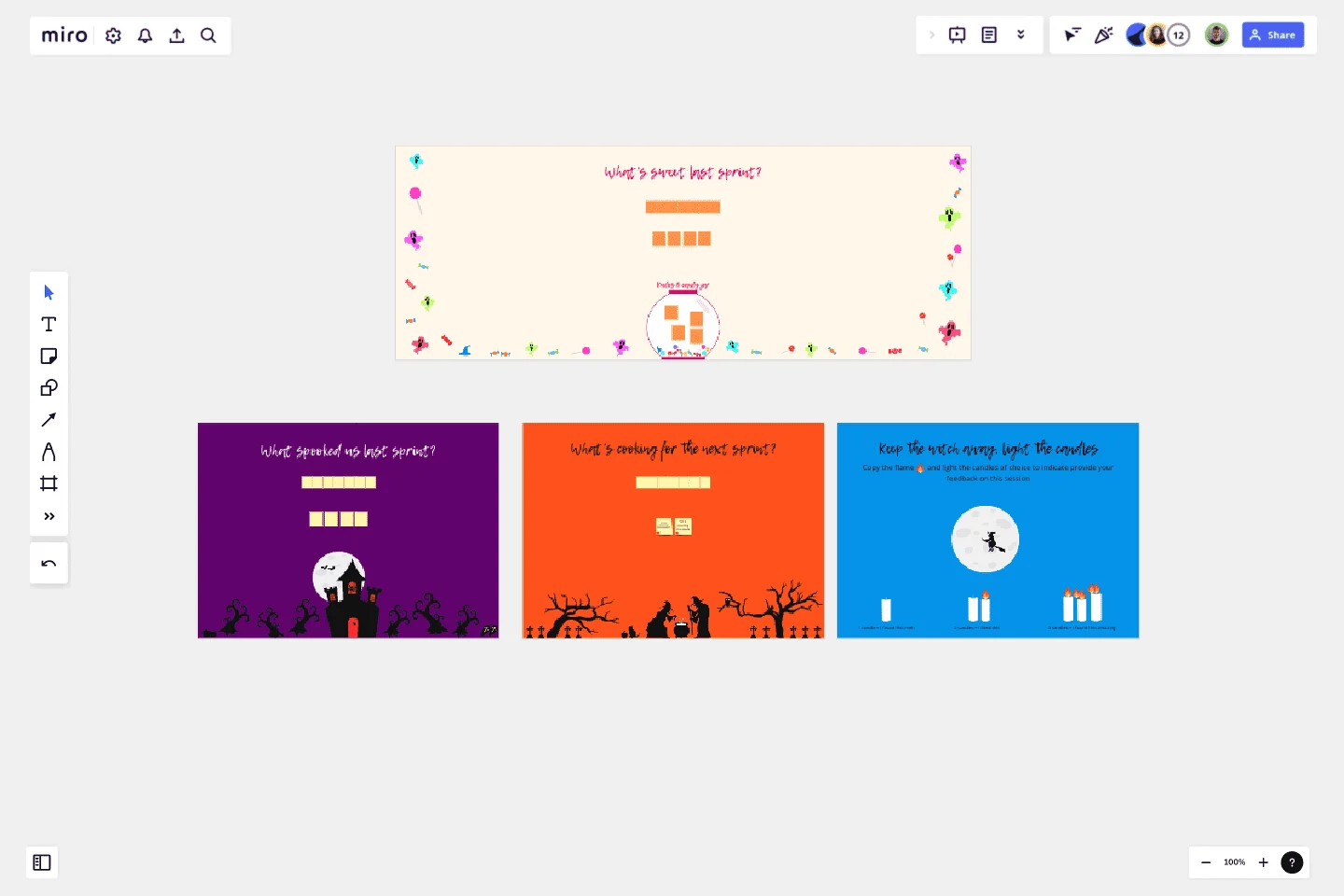A Halloween Retro
Make next steps less spooky and more actionable.
A Halloween Retro
October is Halloween month and if you're hosting a retrospective during this time, how can you even resist a Halloween-themed retro board? Bring out your spooky game, a cup of pumpkin spice latte and gear up to have the best retro of your life!
Halloween Bingo 🎃
For the icebreaker, we have a Halloween-themed bingo! The rules are the same as regular bingo - if you match with a square, mark it with the provided marker. If you complete a row across, down or diagonally, shout B-I-N-G-O! Once everyone has had a chance at marking their bingo sheets, browse around and discover some interesting tales.
What's sweet last sprint? 🍭
Halloween and no candies? Impossible! Drop some kudos in the candy jar to let them know how much their contributions mean to you. Next, make notes on what went well in the past sprint and discuss these points with your team.
What spooked us last sprint? 👻
Okay, this is scary but it has to be done. As a team, make notes of what didn't go well in the last sprint and discuss these points with your team. Don't spend too long here though or else the zombie will step out of his haunted house and make you his next meal.
What's cooking for the next sprint? 🍯
The wizard and the witch may be cooking a magic potion for their next trip, but in the meantime, you can jot down some action points for your next sprint. Based on what didn't go so well, come up with these possible actions to take as a team. Limit the total actions to either two or three, though, because having too many actions may not always be a good thing.
Keep the witch away, light the candles 🧙♀️
A wandering witch on a full moon is never a good idea. Keep her away by quickly lighting some candles. Based on how your team thought the retrospective went, ask them to copy the flame and light the desired group of candles to convey their feedback. Remember, you can have multiple flames for a candle because they're magic candles!
That's it. Happy retrospective!
This template was created by Clyde D'Souza.
Get started with this template right now.
Product x Marketing Roadmap
Works best for:
Product Management, Roadmap
Align product development with marketing strategies using the Product x Marketing Roadmap. This template helps you coordinate product launches, marketing campaigns, and key milestones. Use it to ensure both teams are on the same page, maximizing the impact of your product releases. Ideal for product managers and marketing teams aiming to synchronize their efforts and achieve cohesive, successful product launches and campaigns.
Product / Market Fit Canvas Template
Works best for:
Market Research, Strategic Planning, Product Management
The product/market fit canvas template is used to help product teams meet customer and market needs with their product design. This template looks at a product in two dimensions: first, how the product fits user needs, and second, how the fully designed product fits within the market landscape. This combined metric understands a product holistically from the way customers use and desire a product, to the market demand. By comparing customer and product qualities side by side, users should better understand their product space and key metrics.
Product Reflection
Works best for:
Product Management, Planning
The Product Reflection template encourages teams to reflect on past experiences and lessons learned in product development journeys. By facilitating retrospective sessions, capturing insights, and identifying improvement opportunities, this template fosters a culture of continuous learning and improvement. With sections for evaluating successes, challenges, and areas for growth, it enables teams to iterate on their processes and enhance future product development efforts. This template serves as a tool for fostering team collaboration and driving iterative product innovation.
Customer Touchpoint Map Template
Works best for:
Desk Research, Product Management, Mapping
To attract and keep loyal customers, you have to truly start to understand them—their pain point, wants, and needs. A customer touchpoint map helps you gain that understanding by visualizing the path your customers follow, from signing up for a service, to using your site, to buying your product. And because no two customers are exactly alike, a CJM lets you plot out multiple pathways through your product. Soon you’ll be able to anticipate those pathways and satisfy your customers at every step.
Cynefin Framework Template
Works best for:
Leadership, Decision Making, Prioritization
Companies face a range of complex problems. At times, these problems leave the decision makers unsure where to even begin or what questions to ask. The Cynefin Framework, developed by Dave Snowden at IBM in 1999, can help you navigate those problems and find the appropriate response. Many organizations use this powerful, flexible framework to aid them during product development, marketing plans, and organizational strategy, or when faced with a crisis. This template is also ideal for training new hires on how to react to such an event.
User Story Map Template
Works best for:
Marketing, Desk Research, Mapping
Popularized by Jeff Patton in 2005, the user story mapping technique is an agile way to manage product backlogs. Whether you’re working alone or with a product team, you can leverage user story mapping to plan product releases. User story maps help teams stay focused on the business value and release features that customers care about. The framework helps to get a shared understanding for the cross-functional team of what needs to be done to satisfy customers' needs.
